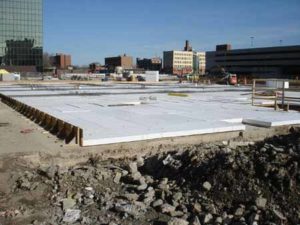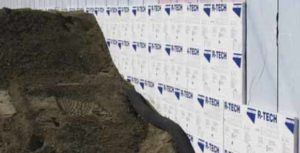Sink or swim: A comparison of below-grade rigid foam insulation moisture performance
Below-grade rigid foam physical properties

To determine which below-grade rigid foam insulation is best to use, it is important to first understand the material’s makeup. Here is a look at three common rigid foam insulation products and their ability to combat moisture.
Expanded polystyrene
Expanded polystyrene (EPS) is a polystyrene resin-based closed-cell insulation material. It is available alone or in combination with other rigid insulations, polymeric facers, and/or backer boards. Historically, EPS was used as a stable roof insulation. In recent years, it has gained wide acceptance in wall, below-grade, and under-slab applications because of its inherent moisture performance, strength, and stable long-term thermal qualities (R-value). Below grade, EPS is a viable option because of its high-density structure that can effectively withstand both backfilling and concrete slab pouring. It is lightweight, resilient, and can be custom-cut into a variety of shapes and sizes to meet a wide range of job specifications. For example, some manufacturers offer EPS board sizes up to 4880 x 1220 x 1020 mm (16 x 4 x 3.33 ft). While this larger size of a board is not typically used in below-grade construction, the customization options of EPS are vast.
One unique component of EPS is manufacturers expand it by using steam, rather than a chemical blowing agent. The natural expansion of the polystyrene foam beads make EPS adept at retaining its thermal insulation R-value over the long-term. This is a key benefit as other rigid foams expanded using a blowing agent can lose up to 30 per cent of its initial R-value over its lifespan. This is reflected in the EPS insulation’s long-term thermal resistant (LTTR) value listing. In application, EPS’ stable R-value helps support lower energy use and costs over a building’s time in service.
Moisture performance of EPS
The steam expansion process bonds EPS’ polystyrene foam beads together with heat rather than chemicals. The heat expansion creates air pockets within the board allowing moisture to uptake into EPS faster than alternative materials, as well as releases it more quickly. In below-grade applications with consistent wet-dry cycles, EPS releases its moisture content rapidly to return to its original R-value.
Extruded polystyrene
Extruded polystyrene (XPS) foam is another polystyrene resin-based closed-cell rigid foam. It is easily recognized by its bright colouring. During manufacturing, molten foam polystyrene beads are extruded through dye and expanded using blowing agents. After this process, the material is formed into blocks or insulation boards up to 2438 x 1220 x 76 mm (96 x 48 x 3 in.).
Moisture performance of XPS

When XPS is extruded through dye, it expands into a uniform, closed-cell rigid foam without voids or pathways for water intrusion. While this allows the XPS foam to uptake water at a slow rate, it also causes the material to release moisture slowly after absorption. In turn, this causes XPS to slowly return to its R-value.
Polyisocyanurate
Polyisocyanurate (polyiso) is another common form of rigid foam insulation. Unlike EPS and XPS, it is not often considered for below-grade use.
Polyiso insulation boards are made with organic and inorganic facer materials such as paper, foil, or fibreglass. The use of a facer plays a role in the insulation’s moisture performance. Foil-faced polyiso boards have permeance (perm), or measure of its allowance to the flow of matter, rating of about 0.3, according to the Polyiso Insulation Manufacturers Association (PIMA). In part, because of their low perm ratings, polyiso products often are used in wall and roof applications.
Moisture performance of polyiso
Most polyiso wall insulation products are very moisture resistant. However, “because the polyiso facer can absorb water, polyiso is not recommended for use under slabs or on the exterior of foundation walls,” notes Green Building Advisor, a website dedicated to the residential construction industry. Although EPS and XPS also absorb moisture, these products do not need a facer, and are not subject to moisture accumulation and retention in the facer’s material. In the absence of a facer material, EPS and XPS can release moisture at their respective rates below grade.


